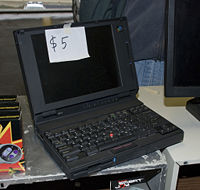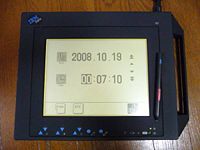ThinkPad: Difference between revisions
imported>Chunbum Park No edit summary |
imported>Chunbum Park |
||
| Line 3: | Line 3: | ||
== History == | == History == | ||
{{Image|IBM Portable Personal Computer.jpg|right|250px|The IBM 5155 portable computer.}} | |||
IBM introduced its first [[portable computer]] ([[IBM Portable Personal Computer|5155 model 68]]) in February 1984 when mobile computing was emerging as a new segment of the PC industry. Although its release was highly anticipated and preceded by falls in stock prices of competitors like [[Compaq]], the "transportable computer" was not successful. | |||
{{Image|IBM ThinkPad 700C.jpg|right|200px|The ThinkPad 700C.}} | {{Image|IBM ThinkPad 700C.jpg|right|200px|The ThinkPad 700C.}} | ||
{{Image|IBM ThinkPad 710T.jpg|right|200px|The ThinkPad 710T, which closely resembled the IBM 2521, later renamed the ThinkPad 700T.}} | {{Image|IBM ThinkPad 710T.jpg|right|200px|The ThinkPad 710T, which closely resembled the IBM 2521, later renamed the ThinkPad 700T.}} | ||
Revision as of 23:40, 11 September 2009
ThinkPad is a professional-oriented brand of laptop and tablet PCs manufactured by Lenovo, which secured the rights to the ThinkPads through its acquisition of the IBM's PC division in 2005. The ThinkPad was first conceived as a dedicated tablet lacking a keyboard, but it emerged as primarily a notebook brand with the successful debut of the models 700 and 700C in October 1992. The 700/C and the subsequent ThinkPad models took the shape of a black rectangular case, featuring a red rubber cap at its keyboard's center as a pointing device.
History
IBM introduced its first portable computer (5155 model 68) in February 1984 when mobile computing was emerging as a new segment of the PC industry. Although its release was highly anticipated and preceded by falls in stock prices of competitors like Compaq, the "transportable computer" was not successful.
I wanted to create a volume as simple as possible and as expressive as possible... and I thought the form of a cigar box, which at that time corresponded to the dimensions... more or less than a laptop computer had to have, would be an expression of what I wanted to do. I wanted to make an object that looks like a black cigar box and that shows on the outside nothing of being what it is... except for the logo of the producer. Then, when you open it, you see this is not a cigar box, but it is a computer, and you see all the complicated stuff inside. And that would create a surprise, and this is the basic concept of the ThinkPad.
- Richard Sapper


